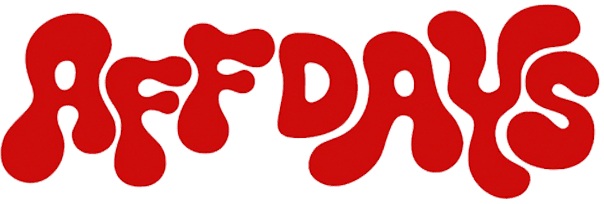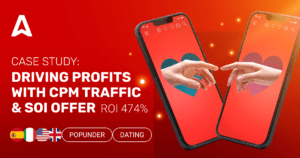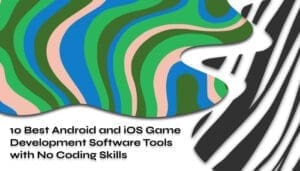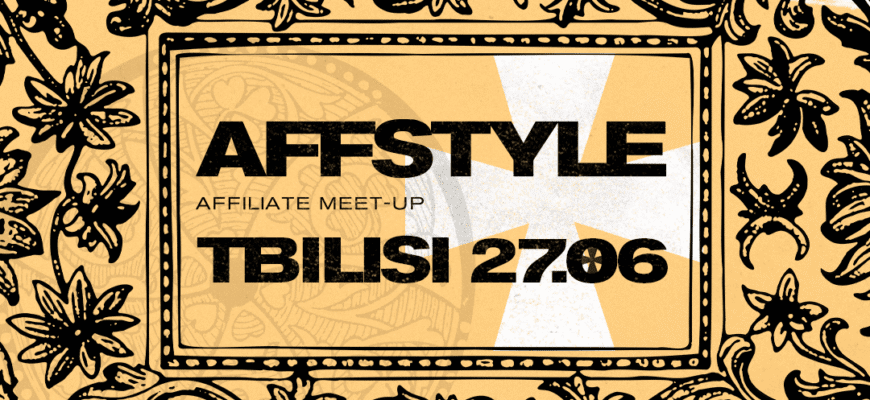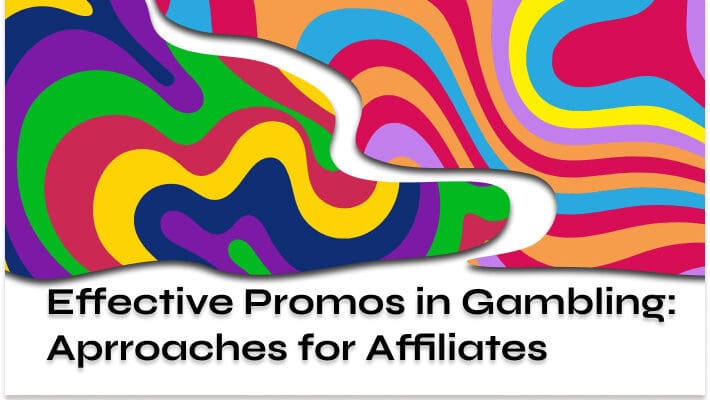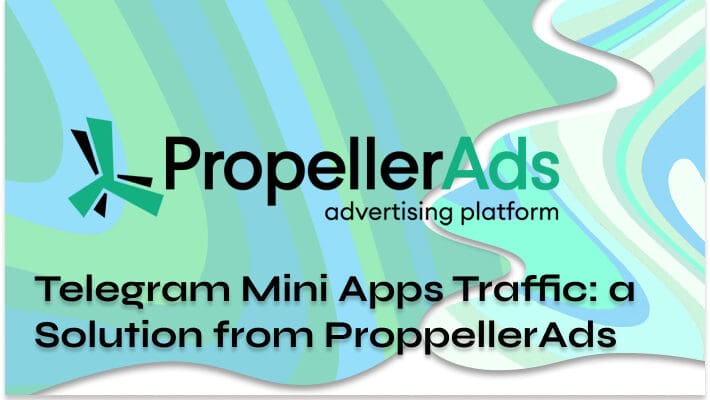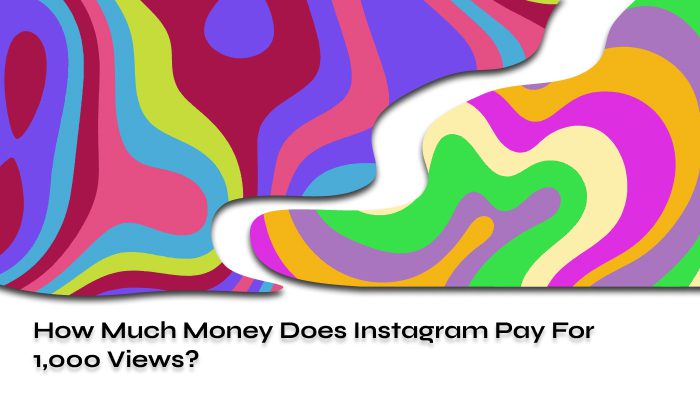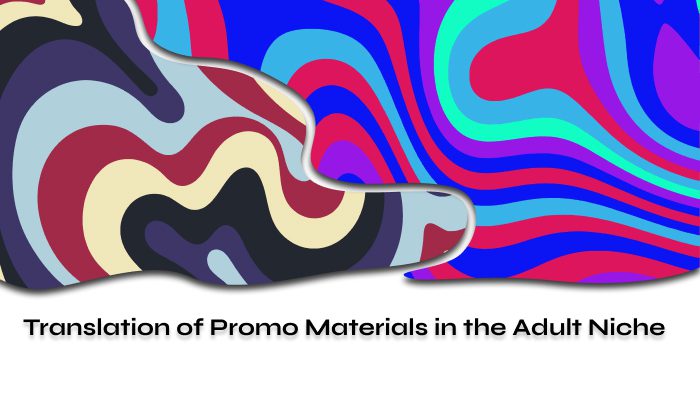The options for advertising formats accessible to marketers have expanded significantly alongside the ascent of digital marketing. They encompass a wide spectrum, ranging from the conventional search ads, display ads, and website pop-ups, to social media platforms like Facebook, Instagram, and Twitter. Additionally, there is the avenue of native advertising within publications or blogs.
Although achieving mastery in a specific traffic avenue is a fine beginning, marketers should contemplate extending their campaigns across multiple channels. After all, digital marketing can exhibit a rather unforseeable nature!
At one moment, substantial profits may be flowing in from a particular source; however, the next instance might witness an abrupt cessation due to a ban. Just like that, one moment and there’s nothing left! But should you give up? Is the logical response to huddle in a corner and lament? While this notion might sound somewhat apocalyptic, experienced affiliates are well aware that such things can transpire at any moment and do A/B testing to see what works better in a particular case. Therefore, it is wise to remain ready to pivot towards an alternative traffic source.
This article aims to illuminate the array of diverse online advertising formats at the disposal of marketers who aspire to gain an advantage over their rivals, or at the very least, those who are striving to expand their reach.
If you work in advertising, you should know not only basics but some practical cases when advertisements went wrong.
- Display Advertising
- Banner Ads
- Banner Ad Placements and Dimensions
- Advantages and Disadvantages of Display Advertising
- Interstitial Ads
- Video Ads
- In-Banner Video Ads
- In-Stream Video Ads
- Out-Stream Video Ads
- Advantages and Disadvantages of Video Ads
- Native Advertising
- The Advantages of Native Ads
- The disadvantages of Native Ads
- Varieties of Native Ads
- In-feed Ads
- In-app Ads
- Content Recommendation Widgets
- Branded Content
- Search Engine Optimization (SEO)
- User Intent
- Search Engine Preferences
- Diverse Varieties of SEO
- On-Page SEO
- Off-Page SEO
- Navigating the Search Engine Landscape
- Sponsored Search Results or Pay-Per-Click Marketing
- Contextual Ads
- Pop Ads
- Zero-Click Ads
- In-Text Ads
- Social Media Marketing
- Organic Social Media Marketing
- Social Media Ads
- Social Media Ad Formats
- Influencer Marketing
- Incentive Ads
- Email Marketing
- Solo Ads
- Push Notification Ads
- Characteristics of Push Ads
- Push Notification Ad Formats
- SMS Marketing
- SMS Message
- MMS Message
- Audio Ads
- Mobile Ads
- Adult Ads
- Conclusion
Display Advertising
Display advertising stands as one of the earliest forms of advertising, you’ve encountered it at least once, even if digital devices aren’t your primary means of interaction.
This genre of advertising has undergone a transformative journey over the years, resulting in the existence of an abundance of formats. These encompass:
Banner Ads
Referred to as display advertising due to its visually oriented nature, banner advertising can usher visitors from the hosting website to a dedicated landing page.
The primary purpose of banner advertising is to cultivate brand awareness. Nevertheless, owing to its extensive proliferation and budget-friendliness, affiliates are also harnessing it to promote affiliate offers.
Empirical studies and trials have consistently demonstrated the attention-commanding prowess of banners, attributed to their imagery, dimensions, and strategic placements. They can take various forms, ranging from single-color compositions accompanied by text (.jpg) to intricate animations crafted in HTML5 or Flash, and even encompass video banners.
One limitation of banner ads is that audiences have grown so accustomed to their presence that they often develop a phenomenon termed “ad blindness.” However, advertisers persistently manage to reach their intended audience due to the sheer volume and expansive outreach inherent to this format.
There are three distinct categories of banner ads:
- Static ads. These banners remain motionless, presenting straightforward images and information designed to seize the user’s attention. Static ads are hassle-free and easier to produce.
- Animated ads. Animated banner ads introduce a sense of motion. This motion could involve scrolling text, flickering lights, altering colors and visuals — elements designed to captivate viewers’ focus by their dynamic nature. Flash ads and GIF ads fall into this category.
- Interactive ads or Rich Media ads. This format serves to enhance user engagement by enabling interaction with the banner through uncomplicated actions, all while keeping the user within the confines of the hosting website’s page. Calls to Action become visible after a designated period of user interaction or after a specified number of actions.
The evolution of ads continues, and considering the growing in video consumption, banner ads have adapted to incorporate in-banner video ads — videos seamlessly integrated within banner placements. Further elaboration is presented in the Video Ads section.
An additional banner ad variant that has emerged recently is the In-Page Push Notification. While technically categorized as a banner ad, its visual design and resemblance to Classic Push Notifications often result in it being grouped under Push Notification Ads.
Banner Ad Placements and Dimensions
Banners adorn various sections of a webpage, including:
- Header
- Footer
- Sidebar
- Within articles
- Below articles
Distinct banner sizes cater to different placements, ensuring optimal website integration whether accessed via computer or mobile device.
Banner ad dimensions are typically quantified by width and height, usually measured in pixels. For instance, a specification like 300x200px indicates an image width of 300 pixels and a height of 200 pixels.
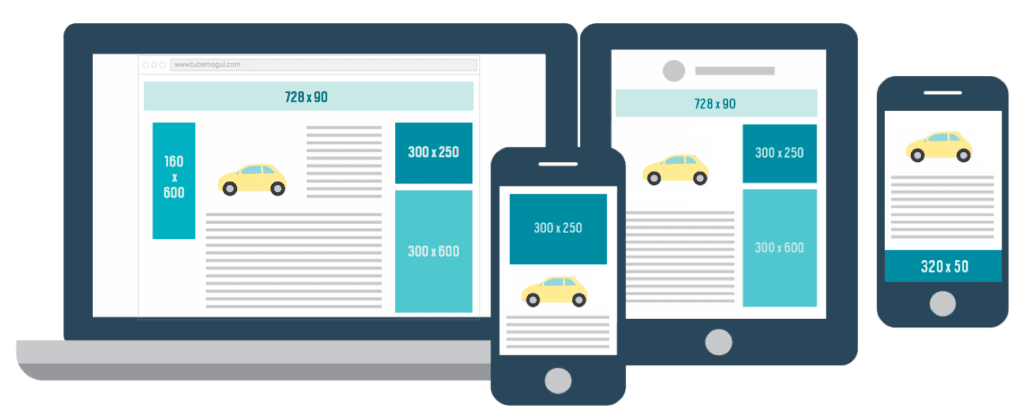
Below, you’ll find a table outlining the variety of banner ad sizes:
| Ad Size | Ad Name | Location |
|---|---|---|
| 300×250 | Medium Rectangle | Within or end of the article |
| 336×280 | Large Rectangle | Within or end of the article |
| 728×90 | Leaderboard | Top or within an article |
| 970×90 | Large Leaderboard | Top of the article or at the header |
| 970×250 | Billboard | Header |
| 300×600 | Half Page | Right or left side of the page |
| 468×60 | Full Banner | Leftside or inside small spaces in the article |
| 234×60 | Half-banner | Leftside or inside small spaces in the article |
| 120×240 | Vertical banner | Sidebar |
| 120×600 | Skyscraper | Sidebar |
| 160×600 | Wide Skyscraper | Sidebar |
| 200×200 | Small Square | Sidebar |
| 250×250 | Square | Sidebar |
| 300×1050 | Portrait | Sidebar |
Advantages and Disadvantages of Display Advertising
- Benefits: you can always reach a wider audience and use customizable formats.
- Drawbacks: unfortunately, there is a chance that people will ignore your ads since users perceive them as being rather intrusive.
Interstitial Ads
Interstitial ads represent an immersive form of advertising that occupies the entire screen space of the host website or application. This ad variant emerges in the midst of content and frequently materializes during seamless transition points, such as progressing to a different gaming level or initiating a new page.
What distinguishes interstitial ads is their comprehensive coverage, setting them apart from other ad configurations. Given their full-screen prominence, users are compelled to engage with the advertisement, even if only for a moment.
This format particularly excels with content like videos and interactive media, such as gaming or application previews.
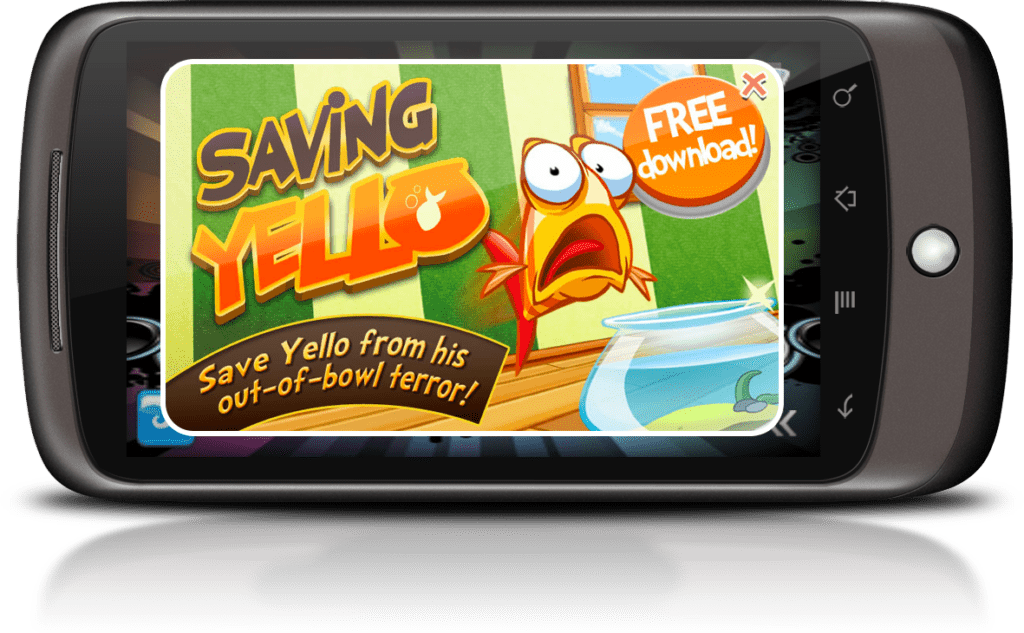
The timing of the available closure option hinges on the ad category. Non-video ads offer an instantaneous exit feature, usually through a Close button or an ‘X’ positioned in a corner. In contrast, video ads necessitate a minimum viewing duration of 10 seconds before they can be terminated.
Interstitial advertisements adopt a responsive design, ensuring they adapt suitably to varying device resolutions, thereby ensuring optimal display quality regardless of the user’s device.
Video Ads
When it comes to captivating those who prefer absorbing content visually, video ads stand as an enticing advertisement format. These ads provide users with an opportunity to assimilate information without the need to peruse lengthy textual content, all the while sustaining their focus and kindling their curiosity.
Three primary categories of video ads exist, each offering distinct attributes:
In-Banner Video Ads
In-banner video ads seamlessly integrate videos into banners. These advertisements make use of the space conventionally reserved for banner advertising (typically 300 x 250 pixels, though an array of platforms is embracing diverse dimensions), offering a dynamic viewing encounter instead of a static image. Although compact, users can expand the video by clicking on an icon.
Engaging with an in-banner video ad doesn’t entail initiating a play button or enduring video loading times. Ordinarily, the audio remains muted as the video starts, ensuring a non-disruptive in-page experience. Once the user’s attention is ensnared by the visual motion, the option to activate sound becomes available.
In-Stream Video Ads
In-stream video ads harmonize with content, manifesting either prior to (pre-roll), during (mid-roll), or subsequent to (post-roll) the streaming video being observed by the user.
Skipping such ads is often contingent on their duration; lengthy ads can be skipped, whereas shorter ones usually necessitate completion. Primarily used to monetize video content for publishers, this format should be wielded carefully by advertisers, deploying succinct and compelling messages due to its potential to appear intrusive to users.
Out-Stream Video Ads
Out-stream videos represent an innovative approach to online advertising. They mirror in-banner video ads but enjoy greater latitude in placement, devoid of the necessity for ad units like banners or pop-ups for seamless functionality.
These videos can be encountered across a spectrum of contexts, spanning articles, social feeds (e.g., Facebook), product pages — effectively any context characterized by text accompanied by a video player provides potential ground for out-stream advertising. Such ads require a player from their hosting platform (e.g., YouTube) for playback.
Upon their appearance onscreen, out-stream videos initiate playback, halting when the user scrolls down, relegating them from view. While an in-banner video ad adheres to the banner’s dimensions, an out-stream video ad exhibits responsiveness, dynamically adjusting to the dimensions of the video player.
In a landscape increasingly oriented towards visual content consumption, video ads emerge as a compelling conduit to captivate and communicate with audiences. Their versatility across these distinct subtypes affords advertisers an array of tools to connect with their target audience in meaningful and engaging ways.
Advantages and Disadvantages of Video Ads
- Benefits: you can produce engaging content that grabs attention and conveys message effectively.
- Drawbacks: it may take a lot of time to create high-quality videos. People may also choose to skip the ad after a few seconds.
Native Advertising
In an era of escalating marketing competition, devising innovative methods to present advertisements without disrupting internet users’ experience becomes paramount. Frequently, viewers perceive advertisements as nothing more than intrusive disruptions to their online engagement. To enhance sales without aggravating users, the avenue of choice is native advertising.
Native advertising stands as the least obtrusive ad format, seamlessly melding with the aesthetics and ambiance of the hosting website. Its integration is so seamless that it often defies identification as an ad, with the exception of mandatory labels like “Sponsored” or “Ad” placed proximate to the content. Snapchat, for example, is a very popular place to make money on, publishing sponsored posts or other paid native advertising. But it only works if you have a loyal fan base.
The Advantages of Native Ads
Native ads offer impeccable visibility within the vast expanse of publisher websites, ranging from countless platforms to thousands of authoritative domains. The prospect of discovering a relevant publishing site aligning with promotional goals is nearly assured.
This format mitigates the phenomenon of ad blindness. The mix of the ad within the webpage prevents instant dismissal, affording the advertisement ample time to convey its allure or value to the user.
Boasting one of the highest click-through rates (CTR) and engagement figures, native ads thrive by exuding a sense of relevance and value that often surpasses conventional digital marketing formats, such as banners.
The disadvantages of Native Ads
Native Ads can be expensive and they also require careful design to avoid misleading users.
Varieties of Native Ads
While ads within search results and social media technically classify as native ads, each occupies its distinct dimension. For the sake of coherence and to minimize confusion while seeking traffic sources for specific ad formats, the subsequent list exclusively encompasses common native ad formats prevalent in native ad traffic networks.
In-feed Ads
Getting in content feeds, in-feed native ads fluidly intertwine with articles. They tend to manifest on platforms like blogs and news sites with infinite scroll functionalities, which are particularly favored for mobile interfaces.
In-app Ads
As the label implies, in-app native ads organically infiltrate applications. These encompass recommendation ads and in-feed commerce ads that seamlessly integrate into games or applications.
This category may also encompass full-page interactive ads, fostering user engagement through interactive experiences or gameplay. Interactive ads consistently outperform traditional image or video ads.
The target audience for this ad variant primarily comprises mobile users, given that applications are usually installed on mobile devices.
Content Recommendation Widgets
Being the most popular native ad, you can easily find it in prominent news, lifestyle and business websites like CNN, People Magazine, and Entrepreneur. These widgets suggest related stories situated immediately after an article or within the sidebar.

Beyond the designations “Sponsored” or “Ad,” these components rarely register as advertisements, seamlessly blending into the content ecosystem.
Native advertising is effective marketing which ensures brand visibility while respecting user experience, marking a pivotal evolution in digital marketing.
Branded Content
Branded content encapsulates content or articles hosted by publishers on their own websites. This content can encompass press releases, reviews, advertorials, or authentic articles originating from advertisers, all with the overarching aim of promoting a brand or business. These materials are regarded as ads, as publishers are remunerated for featuring such content on their platforms.
Explore our top-list of Native Advertising platforms to see recommended platforms.
Search Engine Optimization (SEO)
Ever pondered upon the factors driving certain businesses to secure a spot on the initial page of search engines like Google, Bing, and Yahoo? The answer resides within the realm of SEO.
SEO is a strategy aimed at garnering augmented organic traffic from search engines. This strategy intertwines the following elements:
User Intent
This entails comprehending the online search queries, the phrases and terms employed by users in their search for information, and furnishing them with the desired answers through relevant content.
Search Engine Preferences
While apprehending user intent constitutes one facet of SEO, discerning the predilections of search engines forms the other. How do search engines curate results? How do they assess and track your website? Answering these queries is the key in the optimization process, with an unwavering emphasis on the page’s utility for end-users.
The parameters governing website evaluation by search engines undergo transformations with each platform update. However, one criterion remains immutable — the page’s utility to the end-user.
Diverse Varieties of SEO
Two distinct categories of search engine optimization exist, each wielding its own potential for yielding optimal outcomes. Employing both categories can maximize efficacy, yet it’s entirely plausible to garner traffic and ranking advantages by focusing on either one. These categories are:
On-Page SEO
Also recognized as on-site SEO, on-page SEO necessitates exceptive effort and time investment. Its central objective is twofold: heighten page visibility in Google searches while crafting content that is not only attractive but also resonates with readers, thereby engendering enjoyment or usefulness.
On-page SEO engrosses content enhancement, title and header tag optimization, inclusion of internal and outbound links, integration of meta descriptions, and an array of supplementary measures — essentially encapsulating all on-page actions.
Off-Page SEO
The umbrella term “off-page SEO” encompasses endeavors executed beyond the precincts of your website. These external undertakings possess the potential to influence your search engine ranking, a decisive factor for those seeking credible and authoritative online visibility.
For instance, optimizing your site through off-page SEO entails acquiring backlinks from high-authority websites and garnering substantial social media shares. These endeavors foster signals of trustworthiness and authority, attributes scrutinized by search engines.
Navigating the Search Engine Landscape
Search engines can be likened to mechanized online libraries, sifting through billions of websites to furnish potential answers to users’ inquiries.
It materializes via a technique commonly known as “crawling and indexing.” Subsequently, the search engine algorithm orchestrates the ranking of results aligning with the user’s query through a process termed “ranking.”
Should your website feature a combination of words or phrases conducive to addressing the user’s query, your webpage is ranked based on its relevance. Should your content serve as the quintessential solution to the inquiry and if signals ascertain your authoritative stance on the subject matter, your page goes to the top of the results page.
Elevated ranking augments your prospects of garnering clicks and directing traffic to your website.
Nonetheless, an inherent drawback of SEO pertains to its absence of immediacy. Attaining the anticipated traffic mandates months of consistent, high-quality content production. For individuals yearning to expedite search engine traffic influx, an alternative marketing avenue might be preferable.
Sponsored Search Results or Pay-Per-Click Marketing
If you want an increased influx of traffic through search results but find yourself short on time to optimize or even establish a website, Sponsored Search Results could be your recourse. In this realm, you remunerate search engines to incorporate your website within their search results.
This particular avenue within the realm of Search Engine Marketing adheres to the Pay Per Click (PPC) model, implying that you make payments to the search engine each time a user clicks on your advertisement. Consequently, it is commonly referred to as PPC marketing.
Yet, before embarking on the realm of PPC, a substantial amount of groundwork is needed for successful campaigns. Initially, meticulous research is also needed to cherry-pick the apt keywords for your endeavor. Subsequently, setting up an effective landing page and optimizing it to induce conversions becomes pivotal. Finally, crafting and assessing ad creatives materializes as the concluding step.
Numerous determinants wield influence over the success of your PPC campaigns, they are:
- Keyword Research and Relevance. This involves constructing a pertinent roster of keywords, accompanied by ad text within well-defined keyword groups.
- Landing Page Quality. The crafting of a persuasive landing page replete with pertinent content and a lucid call to action emerges as a prerequisite.
- Quality Score. Esteemed search engines like Google evaluate the quality and relevance of your PPC campaigns, landing pages, and employed keywords. Even in the context of purchased traffic, their priority remains directed towards directing their audience to pages capable of catering to their inquiries.
An elevated Quality Score augments click volume at a reduced cost. Conversely, a suboptimal Quality Score results in limited traffic inflow at an elevated price or possible rejection.
- Creatives. The development of captivating, text-based ad creatives plays a pivotal role in securing enhanced conversions. Conduction of split-testing serves as a pivotal instrument in identifying the top-performing variant.
Search engines harness billions of visitors worldwide, perpetually seeking answers. This attribute positions them as a prodigious source of traffic for your campaigns. Nonetheless, this terrain stands characterized by fierce competition and stringent regulations. An inadvertent misstep could lead to the suspension of your ad account; hence, it is imperative to meticulously peruse all prerequisites prior to initiation.
Text ads stand as the prevalent manifestation of search ads. A PPC text ad comprises:
- Headline. Up to 30 characters per headline (certain search engines allow two to three headlines per ad).
- Description. Up to 90 characters per description.
- Display URL. This can denote your landing page URL or the offer page URL.
Beyond Text Ads, other sponsored search results encompass:
- Call-only Ads or Click2Call Ads. Enabling users to initiate a phone or VOIP call to the advertiser by clicking on the ad.
- Product Shopping Ads. Directing users straight to eCommerce sites or apps.
- App Promotion Ads. Predominantly tailored for mobile searches, these prompt users for immediate redirection to app download pages.
Contextual Ads
Contextual ads are a manifestation of advertising wherein the displayed content corresponds to the context or substance of the hosting website. This form of advertisement functions by automatically analyzing the content and metadata of a webpage and aligning it with the requisites of advertisers.
The efficacy of this mechanism hinges on the utilization of keyword or domain targeting filters employed by ad networks.
Diverse iterations of contextual ads encompass pop ads, zero-click ads, and text ads, each warranting elucidation.
Pop Ads
Termed as On-Click Ads, pop ads materialize as comprehensive page-wide advertisements that open in a distinct browser tab upon the user’s click on any element within the publisher’s website.
Two configurations of pop ads subsist, delineated by their mode of appearance:
- Pop-up. This variant is a tab or browser window overlaying the active browser. Although it instantaneously captures the user’s attention, it is associated with diminished user experience due to its tendency to disrupt ongoing activities. This practice has been restricted by various browsers, including Google Chrome. Nonetheless, select traffic providers persist in offering pop-ups.
- Pop-under. In contrast to pop-ups, pop-unders unveil underneath the active browser, facilitating a more seamless user experience. They come into view solely upon closure of the active tab or browser.
Pop ads adhere to a Pay Per View (PPV) compensation model, thereby being commonly referred to as PPV ads. Among the array of available traffic types, pops stand as a budget-friendly alternative, with certain ad networks vending them for as low as $0.0001 per instance. Run-of-Network (RON) pop traffic offers an even more economical avenue, devoid of keyword filtration. Opting for RON is conducive if voluminous traffic is your prerogative.
Zero-Click Ads
Zero-Click ads manifest as all-encompassing page-wide adverts that necessitate no user interaction by way of clicking. Instead, the user is automatically rerouted to the advertiser’s landing page, often not knowing it.
Domain redirect ads and direct navigation ads are synonymous with zero-click ads, and they trigger under the following scenarios:
- The user inputs an erroneous URL spelling into the address bar, resulting in redirection.
- The domain registration for the intended website has lapsed.
- The website in question no longer exists.
Comparable to pop ads, direct navigation ads follow a remuneration structure grounded in views.
To understand the logic of how people make their choices when searching for a product online, we suggest reading our article on choice overload.
In-Text Ads
In-Text Advertising operates on the premise of underlining and hyperlinking specific words or phrases, thereby grasping the reader’s attention. Hovering the cursor over these marked elements prompts the display of a small box housing ads germane to the word or phrase.
An alternative designation for this form is Inline advertising. The ensuing pop-up advertisements encompass a spectrum spanning related products to advertorials, often featuring a Call to Action button that urges the user to explore the offer’s landing page.
If you encounter a website replete with phrases or words marked by double underlines, it is highly probable that you are navigating a publishing platform for in-text ads.

The payment framework embraced by in-text ads fluctuates contingent upon the advertiser, although CPM (cost per thousand impressions) is a prevalent mode of remuneration.
Social Media Marketing
Social media marketing involves the strategic utilization of social media platforms like Facebook, Twitter, Instagram, Tumblr, TikTok, LinkedIn, and others to foster connections, engage with target audiences, and promote brands, products, or services.
Two primary approaches to garner traffic through social media encompass:
Organic Social Media Marketing
The primary objective of organic social media marketing is to cultivate an engaged user base and stimulate interaction with your business page. Consistently publishing pertinent posts and analyzing their performance to discern the types of content that resonate with your audience and the optimal posting times form the cornerstone of this strategy.
Businesses leveraging organic social media marketing aspire to amplify their reach by prompting followers to like, share, and engage with their content.
Social Media Ads
For rapid outreach and prompt traffic to your website or offers, social media ads present a compelling avenue. These paid promotions are showcased within the feeds of targeted users.
Social media ads prove especially efficacious for endorsing products and offers tailored to specific demographics, given that social media platforms amass demographic insights and segment their user base accordingly.
Owing to their seamless integration within the platform, social media ads are sometimes regarded as native ads.
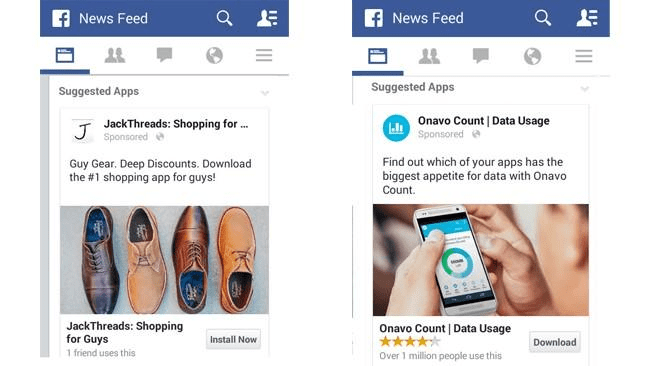
Social Media Ad Formats
Diverse social media platforms encompass distinct ad formats, tailored to their unique feed structures. Some prominent social media ad formats include:
- Text Ads. A straightforward format featuring text content, often with a link. Facebook’s “Boost Post” feature facilitates the promotion of text ads.
- Image Ads. A prevalent ad type comprising an image accompanied by concise or comprehensive text. These can enhance your social media presence or incorporate a CTA button to direct users to your website.
- Carousel Ads. This format enables the presentation of up to 10 images or videos simultaneously, each with its link and CTA button.
- Standard and Dynamic Product Ads. Standard product ads spotlight handpicked products, while Dynamic Product Ads dynamically display products based on user preferences and demographics, facilitating retargeting efforts.
- Collection Ads. This format showcases an array of products within a specific collection or category.
- Interactive Ads. Employing cutting-edge technology and interactive elements, these ads engage users beyond mere clicks. Interactive ads encompass instant experience, messenger ads, story ads, and conversational ads.
- Lead Form Ads. These ads facilitate the accumulation of interested customers’ data, streamlining future communication and outreach efforts.
- Video Ads. Leveraging the ascendancy of video content consumption, video ads capitalize on captivating visuals and are especially effective on platforms like Facebook, where users collectively watch billions of hours of videos daily. Video ad types include pre-roll, mid-roll, and in-feed video ads.
The dynamic realm of social media marketing empowers businesses to forge meaningful connections, nurture engagement, and drive traffic through an array of strategically tailored ad formats.
Influencer Marketing
Influencer marketing revolves around leveraging the reach and credibility of individuals, often celebrities or prominent figures, within specific niches to promote a brand, product, or service. Influencers engage in promotional posts, highlighting the endorsed offering to their followers. This approach is also referred to as “influencer advertising” or “word-of-mouth marketing.”
Influencer marketing is marked by several advantages, including heightened engagement compared to branded social media content. As influencers maintain direct connections with their audiences, posts featuring influencer endorsements typically yield higher engagement rates than those emanating from a brand’s official social media account.
For instance, an Instagram post by an influencer with 1,000 followers may garner more engagement than one from a brand’s account boasting 100,000 followers, owing to the influencer’s deeper rapport with their audience.
Influencer marketing bears semblance to a commercial ad disseminated via social media. Engagement with influencers can be established through direct arrangements or facilitated via Influencer Marketing platforms, which facilitate the identification of suitable influencers based on platform, audience demographics, and interests.
Incentive Ads
Incentive ads, often dubbed rewarded ads, loyalty programs, or gift-based ads, involve enticing users to partake in specific actions such as app downloads, video viewing, game engagement, or online purchases in exchange for rewards, discounts, cashback, virtual currency, and more.
While this ad format necessitates direct negotiations between advertisers and publishers, website and app owners with consistent user bases can utilize their incentive ads to channel traffic towards affiliate offers.
Email Marketing
Email marketing constitutes a promotional strategy involving the dissemination of marketing content via email. This approach encompasses a range of communications, from order confirmations to product updates and special offers. Email marketing, when executed effectively, can maintain customer interest and engagement, but overzealous or excessive emails might lead to unsubscribing.
To embark on email marketing, a compilation of email addresses for marketing purposes is essential. Collection methods encompass:
- Manually Collecting Email Addresses. Utilizing email subscription forms on your website.
- Running Lead Ads. Employing lead generation advertisements.
- Purchasing an Email List. However, this practice is generally not recommended due to issues related to consent and engagement.
An alternative to self-collection or purchasing lists is engaging in Solo Ads.
Solo Ads
Solo ads entail the promotion of an advertiser’s brand or offering via emails dispatched by a list owner to their subscribers. Advertisers provide the email content and compensate the list owner for executing the email campaign.
Payment in solo ads is based on metrics like the number of recipients or the quantity of clicks generated by the email. These transactions are conducted directly with solo ad sellers. Solo ads provide a means for advertisers to tap into an existing subscriber base and amplify their reach within a targeted audience.
Push Notification Ads
Push notification ads are a type of advertising that presents notifications to users’ devices, simulating the appearance of regular notifications. This ad format has gained popularity due to its relatively low susceptibility to fraud and bot traffic. Push notification subscribers willingly opt-in to receive these notifications, ensuring that the traffic generated is genuine and human.
Characteristics of Push Ads
Push notification ads share similarities with the alerts you receive on your smartphone, such as messages, likes, or shares, which appear in a small banner format at the top of your device’s screen. In the context of advertising, these notifications are transformed into marketing messages, forming push notification ads.
A push notification ad generally includes the following components:
- Ad Title. The primary ad text, limited to around 30 characters, which is usually presented in bold.
- Square Icon Image. A small image (192×192 pixels) displayed beside the ad title and description, serving to capture the user’s attention.
- Ad Description. This text appears beneath the ad title and typically allows up to 45 characters, presented in regular size.
- Rectangular Image. An optional image (492×328 pixels) that further attracts the user’s attention, though not all push services support this feature.
- Button. An optional element, mainly applicable to desktop traffic, as mobile push ads are inherently clickable.
A dynamic token is an additional feature that can be integrated into the ad title and description, providing real-time elements such as the user’s country, city, or device name.
Push Notification Ad Formats
Push notification ads encompass three main formats: classic push messages, iOS Calendar Push Notification Service, and in-page push ads.
- Classic Push Notification Ads. These alerts are delivered to users who have previously granted permission to receive notifications. Classic push messages display as banners at the top of mobile devices or in the lower right corner of desktop screens. While they ensure visibility for users who have enabled push notifications, they are not compatible with iOS devices due to Apple’s restrictions.
- In-Page Push Ads. In-page push notifications appear at the bottom of mobile webpages and the lower right or left corners of desktop webpages. They guarantee visibility even if push notifications are disabled on the device. In-page push ads offer broader reach compared to classic push ads, as they can be displayed to iOS users.
- iOS Calendar Push Ads. This recently developed format presents push notifications as reminders from the native calendar app on iOS devices. While these notifications have a higher likelihood of conversion, they may come with relatively higher costs. However, iOS Calendar Push Ads remain relatively rare in the industry.
When considering push notification ads, it’s essential to explore various ad formats and networks to align with your campaign goals effectively. For a comprehensive list of recommended push notification ad networks, refer to reliable industry resources.
SMS Marketing
SMS (Short Message Service) marketing is an effective way to communicate with potential customers by sending short text messages directly to their mobile devices. SMS messages are delivered quickly, are easy to create, and can be sent at any time of day. Research has shown that SMS open rates can be as high as 98%, making it a powerful tool for reaching your target audience.
SMS marketing operates similarly to email marketing in that you need a list of subscribers to whom you can send promotional SMS messages. If you don’t have your own list, you can collaborate with solo ad sellers who will send SMS promotions on your behalf.

SMS ads must adhere to strict compliance requirements to prevent the sender or business from being banned from sending SMS messages. One crucial requirement is to provide an easy opt-out option for users who no longer wish to receive marketing messages.
Each SMS message is limited to 160 characters. Longer messages may result in additional charges. There are two main types of SMS messages you can send:
SMS Message
A standard text message containing only text and possibly a clickable URL. It can be a one-way message from the advertiser to the user or a two-way conversation where users can reply.
MMS Message
An MMS (Multimedia Messaging Service) message includes media such as images, GIFs, audio, and short videos. MMS messages are effective for showcasing product images and engaging users with multimedia content.
Audio Ads
Audio ads are a type of advertising used in audio streaming services and podcast platforms. They are played before or after a specified number of songs or in between podcast episodes. Audio ads are particularly popular on platforms like YouTube Music, Spotify, Amazon’s Alexa, and Soundcloud.
Podcast Ads, a subset of audio ads, are inserted into podcasts during specific time slots:
- Pre-roll. These ads play at the beginning of a podcast episode and typically last 10 to 30 seconds.
- Mid-roll. These ads are inserted in the middle of a podcast episode and are longer, usually lasting 60 to 90 seconds.
- Post-roll. These ads play at the end of a podcast episode and are similar in length to pre-roll ads.
Audio ads are an effective way to increase brand awareness and engagement. Depending on the platform, you may have the option to include an ad description, image, and Call to Action button to enhance the impact of your audio advertising campaign. While audio advertising is still relatively new, its potential for reaching a highly engaged audience is significant.
Mobile Ads
Mobile ads are advertisements specifically designed and optimized for mobile devices, such as smartphones and tablets. They encompass various ad formats that are tailored to mobile screens and user behaviors. Some popular types of mobile ads include:
- In-App Ads: These are ads that appear within mobile applications. They can include banners, interstitials, native ads, and video ads that seamlessly blend with the app’s content.
- Push Notification Ads: Push ads delivered as notifications to a user’s mobile device. They can promote offers, products, or services directly to users who have opted in to receive notifications.
- Mobile Banner Ads: Similar to desktop banner ads, these are smaller graphical or text-based ads that appear at the top or bottom of mobile screens.
- Mobile Video Ads: Video ads specifically created for mobile screens and can appear in various formats, such as pre-roll, mid-roll, and in-feed.
- Mobile In-Feed Native Ads: These ads blend seamlessly with the content in a user’s mobile feed, providing a non-intrusive advertising experience.
Adult Ads
Adult ads refer to advertisements that promote adult content, products, or services. Due to the nature of this content, there are specialized traffic sources and networks that cater to adult traffic inventory. Common adult ad formats include pops, banners, video ads, push notification ads, and native recommendation ads, similar to mainstream ad formats.
Conclusion
Selecting the right advertising channels and ad types depends on your specific marketing goals, target audience, effective and safe personalization and the nature of your offer. It’s essential to test different channels and formats to determine what works best for your campaign. Consider diversifying your traffic sources to reduce risk and maintain a backup if your main source of traffic changes or becomes less effective.
